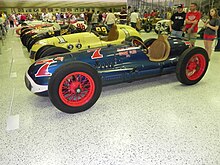|
Bill Holland
Willard Saulsbury Holland (December 18, 1907 – May 20, 1984) was an American racing driver from Philadelphia, Pennsylvania. He won the Indianapolis 500 in 1949 and finished second in 1947, 1948, and 1950. He was runner-up in the 1947 American Automobile Association (AAA) National Championship. BackgroundHolland was born on December 18, 1907, the son of fireman and former professional baseball player Willard Holland. He was excellent at skating and tried out for the 1932 Olympics.[1] Driving careerEarly careerHolland began achieving notable results in big cars during 1937. He recorded his first win on July 30, 1938, at Mineola, New York.[1] He won three times in 1939 and nine times in 1940.[1] Holland finished second to Joie Chitwood in the 1940 AAA Eastern Big Car championship and he won the championship in 1941.[1][2] No racing happened in the United States between 1942 and 1945 due to World War II.[1] In 1946, Holland won 15 Eastern and 1 Midwestern "big car" (now sprint car) races to finish fourth in the AAA national championship.[1] On July 20, 1946, Holland won the first race at Selinsgrove Speedway in an American Automobile Association-sanctioned event.[1] Championship car careerHolland nearly won the 1947 Indianapolis 500 as a rookie, but slowed and allowed teammate Mauri Rose to pass him seven laps from the end, mistakenly believing that Rose was a lap down.[1]  In 1949 Holland led late in the race when Rose (still teammate to Holland on Lou Moore's Blue Crown Spark Plug team) began to slowly close on Holland. Moore saw what was happening out on the track and hung out a pit board ordering both drivers to hold their respective positions to the finish. Rose picked up the pace, closing on Holland. But with eight laps to go, Rose suffered a magneto failure and Holland cruised to the victory. When Rose returned to the pits, Moore fired Rose on the spot. 1950 saw him a lap down on lap 138 in second place to Johnnie Parsons when rain fell and ended the race. On November 14, 1951, Holland was suspended from AAA Indy Car racing for one year after competing in a three-lap Lion's Charity race at Opa-locka, Florida which was a NASCAR event. The American Automobile Association, at the time the sanctioning body for Indy car races, had a strict rule forbidding its drivers from participating in any races other than their own and would blacklist violators. He returned to Indy car racing in 1953.[1] Holland raced until 1965.[1] He is believed to have achieved more than 40 sprint car feature wins and 150 podiums.[1] World Drivers' Championship careerThe AAA/USAC-sanctioned Indianapolis 500 was included in the FIA World Drivers' Championship from 1950 through 1960. Drivers competing at Indianapolis during those years were credited with World Drivers' Championship participation, and were eligible to score WDC points alongside those which they may have scored towards the AAA/USAC National Championship. Holland participated in two World Drivers' Championship races at Indianapolis. He finished in the top three once,[3] and scored six World Drivers' Championship points. Life after racing and deathHolland and his wife Myra ran skating rinks in Bridgeport, Connecticut.[4] They lived briefly in Colorado Springs, Colorado before moving to Tucson, Arizona in the early 1970s.[4] Holland was diagnosed with Alzheimer's disease in November 1983 and died from complications of the disease on May 20, 1984.[1] He had remained active throughout his life and would regularly ride a bicycle for 50 miles per day until a year before his death.[4] Awards and honorsHolland has been inducted into the following halls of fame: In addition, the inaugural USAC Silver Crown Series race held at Selinsgrove Speedway was named the Bill Holland Classic.[6] The race was 74 laps long as it was the 74th year after Holland's victory opened the track.[6] Motorsports career resultsAAA Championship Car results
Indianapolis 500 results
FIA World Drivers' Championship results(key)
References
External links
Information related to Bill Holland |
|||||||||||||||||||||||||||||||||||||||||||||||||||||||||||||||||||||||||||||||||||||||||||||||||||||||||||||||||||||||||||||||||||||||||||||||||||||||||||||||||||||||||||||||||||||||||||||||||||||||||||||||||||||||||||||||||||||||||||||||||||||||||||||||||||||||||||||||||||||||||||||||||||||||||||||||||||||||||||||||||||||||||||||||||||
